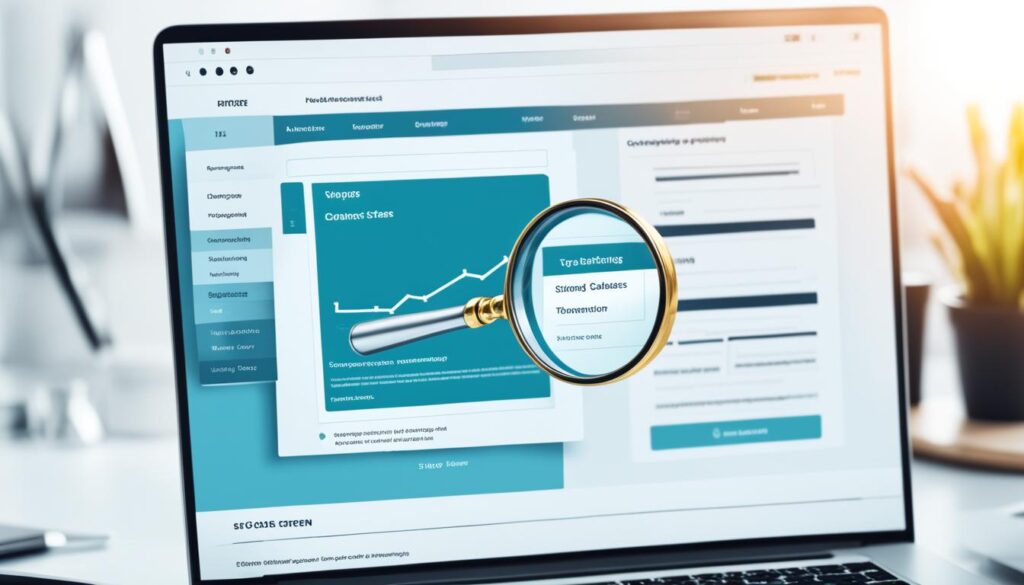Are you aware that global e-commerce sales are projected to reach $6.54 trillion by the year 2022? As online shopping continues to grow in popularity, it is crucial for businesses to maximize their sales potential. Providing seamless transactions, improved security, and reliable customer support through ecommerce merchant services is essential for achieving success.
Key Takeaways:
- Ecommerce merchant services are essential for optimizing sales in the booming online marketplace.
- Seamless transactions, enhanced security, and reliable customer support are vital for attracting and retaining customers.
- Global e-commerce sales are projected to reach $6.54 trillion by 2022, highlighting the immense opportunity in the online business realm.
Focus on the Customer Experience
Creating a frictionless checkout experience is crucial for improving customer conversions and driving sales in the competitive world of e-commerce. By focusing on enhancing the customer experience, you can build trust, increase customer loyalty, and differentiate yourself from competitors. Here are some strategies to help you optimize the checkout process and provide a seamless journey for your customers:
Analyze Competitors’ Websites
Conducting competitor analysis is a valuable exercise that can provide insights into best practices and innovative approaches to improve the customer experience. Visit your competitors’ websites and explore how they have designed their checkout processes. Pay attention to user flows, the number of steps required to complete a purchase, and any alternative payment methods they offer.
By studying your competitors’ successes and failures, you can gain inspiration and innovative ideas to implement on your own website to enhance the customer experience.
Implement a Frictionless Checkout Design
A frictionless checkout design focuses on minimizing obstacles and simplifying the purchasing process, enabling customers to complete their transactions quickly and easily. Consider implementing a one-page checkout system that eliminates the need for multiple steps, reduces form fields, and streamlines the payment process. This streamlined approach can significantly reduce checkout abandonment rates and increase customer satisfaction.
Offer Alternative Payment Methods
Providing your customers with a variety of payment options can help cater to their individual preferences and increase the likelihood of completing a purchase. Consider offering alternative payment methods such as “buy now, pay later” options, ACH transfers, or even cryptocurrency. These alternative methods can improve the customer experience and attract a broader range of customers.
Focus on Mobile Optimization
With the rise in mobile shopping, optimizing the customer experience for mobile devices is essential. Ensure that your website and checkout process are mobile-friendly, with responsive designs and easy-to-use interfaces. This will facilitate a smooth and seamless checkout experience for customers browsing on their smartphones or tablets.
Continuously Monitor and Improve
Improving the customer experience is an ongoing effort. Monitor and analyze key performance metrics related to your checkout process, such as cart abandonment rates, conversion rates, and customer feedback. Use this data to make informed decisions and implement iterative improvements to further optimize the customer experience.
With a focus on the customer experience, you can differentiate your online store from competitors, increase customer satisfaction, and ultimately drive more sales. By implementing a frictionless checkout process, offering alternative payment methods, and continuously refining your strategies based on customer feedback and competitor analysis, you can position your brand as a leader in providing a seamless and enjoyable shopping experience.
Know Why Transactions Get Declined
Understanding the reasons behind transaction failures is crucial in optimizing payment systems. Many business owners are unaware of why transactions get declined. It is essential to identify common issues such as insufficient funds and address them appropriately, such as by offering alternative payment options. Additionally, reviewing and adjusting the settings of your payment gateway’s address verification can help prevent unnecessary transaction rejections.
When it comes to transaction failures, insufficient funds often play a significant role. Customers may attempt a purchase without having enough money in their bank accounts or credit cards, resulting in a declined transaction. To address this issue, consider offering alternative payment options such as installment plans, digital wallets, or buy-now-pay-later services. This allows customers with limited funds to proceed with the purchase and increases the likelihood of successful transactions.
Another aspect to consider is the address verification process. Payment gateways typically perform address verification to ensure the accuracy of billing information. However, strict settings can lead to legitimate transactions being declined. By reviewing and adjusting the address verification settings based on your target audience and industry standards, you can reduce the chances of unnecessary transaction rejections while maintaining the necessary level of security.
Common Reasons for Transaction Failure:
- Insufficient funds in the customer’s account.
- Error in entering payment information.
- Expired or deactivated credit/debit cards.
- Technical issues with the payment gateway.
- Inconsistent or mismatched billing and shipping addresses.
By understanding these common reasons for transaction failure and addressing them effectively, you can optimize your payment system, increase successful transactions, and ultimately improve your online sales.

Protect Yourself Against Fraud
Fraud can have significant financial implications for e-commerce merchants, as it can lead to increased expenses and potential termination by payment processors. To safeguard your online business and prevent fraudulent activities, it is essential to implement effective fraud prevention measures and utilize advanced fraud detection tools.
Relying solely on address verification for fraud filtering may not provide sufficient protection. It is crucial to leverage robust fraud detection tools that analyze various risk factors, such as IP geolocation and email validation, to identify suspicious transactions and potential fraud attempts. By incorporating these tools into your payment processing system, you can enhance your fraud prevention capabilities and minimize the risk of chargebacks and financial losses.
| Fraud Prevention Measures | Benefits |
|---|---|
| Implement advanced fraud detection tools | Improved accuracy in identifying fraudulent transactions |
| Utilize IP geolocation and email validation | Enhanced risk assessment for better fraud prevention |
| Regularly monitor and analyze transaction data | Early detection of suspicious patterns or activities |
| Establish a chargeback protection plan | Reduced financial losses due to chargebacks |
By investing in fraud prevention measures and utilizing sophisticated fraud detection tools, you can protect your business from fraudulent activities and ensure secure and reliable payment transactions. Remember that the cost of implementing fraud prevention measures is significantly lower than the potential financial losses incurred from fraudulent transactions and chargebacks.

Consolidate Third-Party Apps
In the world of payment processing, using multiple third-party apps can lead to higher expenses and compromised data privacy. Consolidating and streamlining your payment apps and tech stack can help optimize e-commerce payments, reduce costs, improve website performance, and enhance data privacy. By streamlining your payment processes, you can focus on providing a seamless and secure payment experience for your customers.
The Benefits of Consolidating Third-Party Apps
Consolidating third-party apps used in payment processing brings several advantages:
- Cost Reduction: Using multiple payment processors can result in additional fees, including payment processor fees and transaction fees. By consolidating your payments, you can negotiate better rates and reduce overall costs.
- Improved Efficiency: Working with a single payment gateway and processor simplifies your operations and reduces the time spent managing multiple platforms. This leads to improved efficiency and a streamlined payment process.
- Better Data Privacy: Each third-party app you integrate with your website potentially has access to customer data. Consolidating these apps minimizes the risk of data breaches and unauthorized access to sensitive customer information.
Consolidating your payment apps also allows for better management of recurring subscriptions and upsells. By having a unified system, you can easily track and manage subscription renewals, billing cycles, and upselling opportunities. This ensures a seamless experience for your customers and helps increase revenue.
Consolidating third-party apps may require some initial effort to migrate your existing setup to a single platform. However, the long-term benefits, including cost savings and enhanced data privacy, make it a worthwhile endeavor for any e-commerce business.
Consolidated Payment Apps Example
To demonstrate the benefits of consolidating payment apps, take a look at this example of an e-commerce business that streamlined its payment processes:
| Previous Setup | Consolidated Setup |
|---|---|
|
|
By consolidating their payment apps, this e-commerce business was able to simplify their payment processes, reduce costs by eliminating redundant fees, and centralize their subscription management. This resulted in a more efficient operation, improved customer experience, and enhanced data privacy.
Overall, consolidating third-party apps is a strategic move for e-commerce businesses looking to optimize their payment processes, reduce expenses, and enhance data privacy. It allows you to focus on providing an exceptional customer experience while ensuring a secure and seamless payment journey.

Keep Your Processor in the Loop
Effective communication with your payment processor is essential to ensure smooth payment processing operations and avoid surprises or potential issues. By keeping your payment processor informed about significant changes in your business, you can proactively address any potential problems and maintain a seamless payment experience for your customers.
One crucial aspect of keeping your payment processor in the loop is notifying them about any changes in your business, such as launching new product lines or experiencing significant sales increases. These changes can have a direct impact on your payment processing needs, and informing your processor allows them to adjust their services accordingly, ensuring uninterrupted payments for your customers.
Additionally, by providing your payment processor with valuable information about your business changes, you enable them to align their risk department’s efforts with your evolving needs. This collaboration strengthens your risk management strategy and reduces the likelihood of false positives or unnecessary transaction rejections.
Building a strong relationship with your payment processor also comes with benefits beyond risk management. They can provide valuable insights and suggestions for optimizing your payment processing, taking advantage of their expertise in the industry.
Overall, open and transparent communication with your payment processor is the key to maintaining a strong partnership. By keeping them informed about your business changes, you can ensure a smooth payment experience for your customers, mitigate potential issues, and optimize your payment processing operations.

| Benefits of Keeping Your Processor in the Loop | Actions |
|---|---|
| Seamless payment processing | Inform your processor about important business changes |
| Efficient risk management | Collaborate with your processor’s risk department |
| Opportunity for optimization | Seek insights and suggestions from your processor |
Understand Your Payment Processing Costs
Optimizing profits and minimizing monthly expenses is essential for any business, and understanding your payment processing fees plays a significant role in achieving this goal. By analyzing your processing statement, you can uncover hidden fees and unexpected rate increases that could have a significant impact on your bottom line. Taking the time to dig deeper into your payment processing costs allows you to make informed decisions that save money and enable better business investment.
Uncovering Hidden Fees
Payment processing fees can sometimes be accompanied by hidden charges that you may not be aware of. These hidden fees can add up over time and eat into your profits, affecting your overall financial performance. By carefully examining your payment processing statement, you can identify any surcharges, transaction fees, or other unexpected costs that may be impacting your business.
“To optimize your profits, it’s crucial to pay attention to the fine details of your payment processing statement. Hidden fees can quietly drain your revenue, and it’s important to identify and address them promptly to maintain a healthy bottom line.”
– Payment Processing Expert
Once you have identified any hidden fees, you can then take the necessary steps to minimize or eliminate them. This could involve negotiating with your payment processor for more favorable terms or exploring alternative payment solutions that offer transparent pricing structures.
Unexpected Rate Increases
Another aspect of payment processing costs to keep an eye on is rate increases. Payment processors may raise their rates without prior notice, resulting in higher fees for each transaction. This can significantly impact your business’s profitability if left unchecked.
Regularly reviewing your payment processing fees and rates allows you to identify any sudden increases and take appropriate action. You may consider reaching out to your payment processor to understand the reason behind the rate increase or explore other providers that offer competitive pricing.
Being aware of potential rate increases empowers you to make informed decisions about your payment processing strategy and adjust your budget accordingly.
Comparing Effective Rates
Effective rate is an important metric to consider when evaluating payment processing costs. It represents the actual percentage of each transaction that you pay in fees, taking into account all relevant fees and charges.
Comparing the effective rates offered by different payment processors can help you determine which one provides the best value for your business. It is important to remember that the lowest effective rate may not always be the most advantageous option if it comes with subpar service or hidden fees. Finding a balance between cost-effectiveness and service quality is key.
| Payment Processor | Effective Rate | Additional Fees |
|---|---|---|
| Payment Processor A | 2.5% | $0.25 per transaction |
| Payment Processor B | 2.9% | No additional fees |
| Payment Processor C | 2.2% | No additional fees |
Comparing effective rates helps you make informed decisions about which payment processor offers the best value for your business while taking into account any additional fees that may apply. Choosing the right payment processor can significantly impact your financial success in the long run.

By understanding your payment processing costs and actively managing them, you can optimize your profits and allocate resources more effectively. Keep a close eye on hidden fees, monitor for rate increases, and compare effective rates to ensure you have the best payment processing solution for your business.
Build Brand Awareness
Growing brand awareness is crucial for increasing sales in e-commerce. By focusing on quality content, collaborating with influencers, utilizing paid advertisements, and maintaining an active presence on social media, you can enhance your brand’s visibility. Brand awareness leads to increased trust, repeat purchases, and improved search engine optimization.
Quality Content
One of the most effective ways to build brand awareness is through the creation of quality content. By publishing insightful blog posts, informative product videos, and engaging social media content, you can establish your brand as an authority in your industry. Focus on providing value to your audience and delivering content that educates, entertains, and inspires.
Influencer Partnerships
Collaborating with influencers can significantly boost your brand’s visibility and credibility. Identify influencers who align with your target audience and brand values, and establish partnerships that involve product endorsements, sponsored content, or guest appearances. The influencer’s endorsement can help you reach a wider audience and build trust with their followers.
Paid Ads
Utilizing paid advertisements is another effective way to increase brand awareness. Platforms like Google Ads and Facebook Ads offer targeted advertising options that allow you to reach your ideal customers. By carefully designing ad campaigns and targeting relevant keywords and demographics, you can increase your brand’s visibility and drive traffic to your e-commerce store.
Social Media Presence
Maintaining an active presence on social media platforms is essential for brand awareness. Consistently posting engaging content, responding to comments and messages, and participating in relevant conversations can help you connect with your audience and build a loyal following. Choose platforms that align with your target audience and focus on creating a consistent brand voice.
“Building brand awareness is like laying the foundation for a successful e-commerce business. It helps you establish credibility, connect with your audience, and differentiate yourself from competitors.”

By implementing these strategies, you can effectively build brand awareness and increase sales for your e-commerce business. Focus on creating quality content, leveraging influencer partnerships, utilizing paid advertisements, and maintaining an active presence on social media. These efforts will pay off as your brand gains visibility, trust, and recognition in the market.
| Benefits of Building Brand Awareness |
|---|
| Increased customer trust |
| Higher chances of repeat purchases |
| Improved search engine optimization |
Build Email Lists and Use Email Marketing
Building and effectively managing an email marketing strategy can greatly contribute to increasing e-commerce sales. By growing your email list with quality leads, you can establish direct communication with customers, encourage repeat purchases, and provide personalized offers and updates. Email marketing offers a long-term engagement strategy with high ROI potential.
One of the key benefits of email marketing is its ability to engage with customers on a personal level. By segmenting your email list based on customer preferences, demographics, and purchase history, you can tailor your messages to resonate with each individual recipient. This personalized approach enhances customer engagement and fosters a sense of loyalty towards your brand.
Another advantage of email marketing is its potential to drive repeat purchases. By sending regular newsletters, promotional emails, and exclusive discounts to your subscribers, you can keep your brand top of mind and entice customers to make additional purchases. Maintaining a consistent presence in their inbox helps to nurture customer relationships and encourages continued engagement with your business.
Additionally, email marketing offers an effective strategy for customer retention. By regularly providing valuable content, product updates, and customer support through email, you can demonstrate your ongoing commitment to your customers’ satisfaction. This continuous engagement helps to build trust and loyalty, increasing the likelihood of repeat purchases and long-term customer retention.
To make the most of your email marketing efforts, it is important to use email automation tools and analytics to track the performance of your campaigns. By monitoring open rates, click-through rates, and conversions, you can identify which emails are resonating with your audience and optimize your future marketing strategies accordingly.
“Email marketing remains one of the most effective channels for customer engagement, repeat purchases, and customer retention in the e-commerce industry.”
Tips for Successful Email Marketing
- Offer exclusive discounts and promotions to incentivize purchases
- Personalize your emails based on customer data and preferences
- Use compelling subject lines to increase open rates
- Segment your email list to target specific customer groups
- Provide valuable content and useful information in your emails
- Use responsive email templates to ensure a seamless experience across devices
By implementing these tips and incorporating email marketing into your overall e-commerce strategy, you can effectively engage with your customers, drive repeat purchases, and improve customer retention in the competitive online marketplace.
Email Marketing Performance Metrics
To measure the success of your email marketing campaigns, it is important to track and analyze key performance metrics. Here are some of the most important metrics to monitor:
| Metric | Description |
|---|---|
| Open Rate | The percentage of recipients who open your email |
| Click-Through Rate (CTR) | The percentage of recipients who click on a link within your email |
| Conversion Rate | The percentage of recipients who complete a desired action, such as making a purchase |
| Bounce Rate | The percentage of emails that are not delivered to recipients’ inboxes |
| Unsubscribe Rate | The percentage of recipients who choose to unsubscribe from your email list |
By regularly monitoring these metrics and making data-driven optimizations to your email marketing campaigns, you can improve performance and achieve your sales and engagement goals.

Test and Test to Avoid Complacency
When it comes to optimizing your e-commerce sales, never underestimate the power of testing. Continually conducting A/B tests and experimenting with different elements on your website can significantly improve your conversion rates and overall sales performance. By making data-driven decisions based on real-time insights, you can ensure that your website is optimized for maximum conversions.
One key area to focus on is conversion rate optimization (CRO). This involves analyzing user behavior, identifying areas that are causing friction or drop-offs, and making improvements to optimize the conversion process. Through A/B testing, you can compare different versions of your website and determine which elements are most effective in driving conversions.
Website optimization is a dynamic process that requires continuous testing and refinement. Consider testing various elements such as button placement, calls to action, product photography, and even color schemes. By testing these elements and gathering data on user engagement and conversion rates, you can gradually improve your website’s performance.
“Testing is an invaluable tool for e-commerce businesses. It helps you identify what works and what doesn’t, enabling you to make data-driven decisions that lead to better outcomes,” says Sarah Johnson, CEO of a successful e-commerce brand.
Implementing a data-driven approach to testing ensures that you are not making assumptions or relying on guesswork. By analyzing customer behavior and preferences, you can gain valuable insights and tailor your website to meet their needs. This approach enables you to constantly optimize and refine your online store, keeping it fresh and engaging for your customers.
By consistently testing and refining your website, you can avoid complacency and continually improve your e-commerce performance. Testing is not a one-time activity but an ongoing process that allows you to adapt to changing market trends and customer preferences. Embrace a culture of experimentation and data-driven decision-making to stay ahead of the competition and drive sustainable growth.
| Benefits of Testing and Optimization | Key Strategies |
|---|---|
| 1. Increased conversion rates | 1. Conduct A/B tests |
| 2. Improved user experience | 2. Analyze user behavior |
| 3. Enhanced customer satisfaction | 3. Optimize website elements |
| 4. Higher revenue and profitability | 4. Implement a data-driven approach |

By testing and optimizing your website, you can unlock its full potential and drive higher conversion rates and increased revenue. Remember, success in e-commerce is not just about launching a great website; it’s about continuously improving and refining it to meet the ever-changing needs and expectations of your customers.
Conclusion
Optimizing e-commerce sales requires a comprehensive approach that focuses on key strategies. By improving the customer experience, preventing fraud, consolidating payment apps, and effectively managing email marketing, online businesses can significantly enhance their performance and drive sales growth.
One of the key aspects in optimizing e-commerce sales is to prioritize the customer experience. This involves creating a seamless and frictionless checkout process, offering alternative payment methods, and analyzing competitors to gather insights for improvement.
Fraud prevention is another crucial strategy. E-commerce merchants should implement advanced fraud detection tools and chargeback protection measures to ensure the security of transactions and protect their bottom line.
Consolidating payment apps and staying in constant communication with the payment processor can also streamline operations and foster a more efficient payment processing system. Additionally, understanding payment processing costs and building brand awareness through quality content, influencer partnerships, paid ads, and a strong social media presence are key strategies for optimizing e-commerce sales.
By continuously testing and optimizing the website through A/B testing and data-driven decisions, businesses can improve their conversion rates and overall sales. It is important to implement these key strategies together to achieve the best results and drive success in e-commerce sales optimization.
FAQ
What are ecommerce merchant services?
How can I improve the customer experience in my online store?
Why do transactions get declined and how can I address it?
How can I protect my business from fraud?
How can I optimize my payment processing?
How important is communication with my payment processor?
How can I understand and manage my payment processing costs?
How can I build brand awareness for my ecommerce business?
How can email marketing contribute to increasing ecommerce sales?
What role does testing play in improving ecommerce sales?
What strategies should I implement to optimize my ecommerce sales?
How Can Ecommerce Merchant Services Help Improve Sales in a Retail Store?
Ecommerce merchant services can improve sales in a retail store by optimizing retail store displays. By offering online payment options and integrating inventory management, customers can easily purchase items both in-store and online. This seamless shopping experience can attract more customers and increase sales for the retail store.









